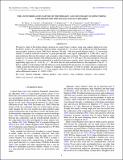THE ANTICORRELATED NATURE OF THE PRIMARY AND SECONDARY ECLIPSE TIMING VARIATIONS FOR THE KEPLER CONTACT BINARIES
Author(s)
Borkovits, T.; Csizmadia, Sz.; Kalomeni, B.; Tran, Ky-Anh; Levine, Alan M; Rappaport, Saul A; ... Show more Show less
DownloadTran-2013-THE ANTICORRELATED N.pdf (1.884Mb)
PUBLISHER_POLICY
Publisher Policy
Article is made available in accordance with the publisher's policy and may be subject to US copyright law. Please refer to the publisher's site for terms of use.
Terms of use
Metadata
Show full item recordAbstract
We report a study of the eclipse timing variations in contact binary systems, using long-cadence lightcurves from the Kepler archive. As a first step, observed minus calculated (O – C) curves were produced for both the primary and secondary eclipses of some 2000 Kepler binaries. We find ~390 short-period binaries with O – C curves that exhibit (1) random walk-like variations or quasi-periodicities, with typical amplitudes of ±200-300 s, and (2) anticorrelations between the primary and secondary eclipse timing variations. We present a detailed analysis and results for 32 of these binaries with orbital periods in the range of 0.35 ± 0.05 days. The anticorrelations observed in their O – C curves cannot be explained by a model involving mass transfer, which, among other things, requires implausibly high rates of ~0.01 M[subscript ☉] yr[superscript –1]. We show that the anticorrelated behavior, the amplitude of the O – C delays, and the overall random walk-like behavior can be explained by the presence of a starspot that is continuously visible around the orbit and slowly changes its longitude on timescales of weeks to months. The quasi-periods of ~50-200 days observed in the O – C curves suggest values for k, the coefficient of the latitude dependence of the stellar differential rotation, of ~0.003–0.013.
Date issued
2013-08Department
Massachusetts Institute of Technology. Department of Physics; MIT Kavli Institute for Astrophysics and Space ResearchJournal
Astrophysical Journal
Publisher
IOP Publishing
Citation
Tran, K., A. Levine, S. Rappaport, T. Borkovits, Sz. Csizmadia, and B. Kalomeni. “ THE ANTICORRELATED NATURE OF THE PRIMARY AND SECONDARY ECLIPSE TIMING VARIATIONS FOR THE KEPLER CONTACT BINARIES .” The Astrophysical Journal 774, no. 1 (August 19, 2013): 81. © 2013 The American Astronomical Society
Version: Final published version
ISSN
0004-637X
1538-4357